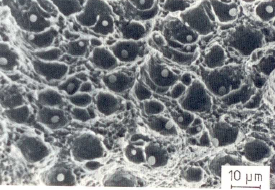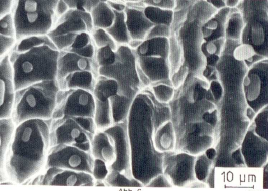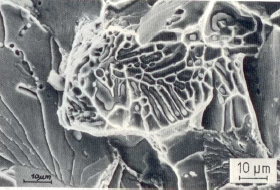Comb rupture
Compared to brittle fracture, this ductile fracture occurs only after significant plastic deformations and features slow crackgrowth. In case of uniaxial tensile stress, the cross-section of the casting is significantly reduced before fracture (necking). Since scientists found out that there is a close connection between the extent of necking until fracture and the degree of pureness of the materials, it seemed logical to assume that the formation and growing together of internal cavities and inclusions or precipitations is the decisive mechanism for crack progression in case of ductile fracture.
This formation of cavities has been proven in the meantime by electron microscope analyses. Depending on the bond strength between particle and matrix, the particle will be torn open at the surface between particle and matrix, or it will break. The reason for this separation is to be found in the different elastic and plastic properties of particle and matrix.
Cavities are formed due to the multiaxial stress situation at the pores, and the fracture proceeds due to the rupture of the webs separating the cavities. The enlarged cavities are visible on the fracture surface as pits or combs, and the web residues which form stretched sharp edges are visible as comb boundaries. The microfractographic figure of the rupture surface thus reflects the mechanism of crackgrowth. It does neither much depend on the crystal structure of the metal, nor does the microfractographic picture suggest any grain boundaries. Examples of comb rupture are given in figures 1 to 3




